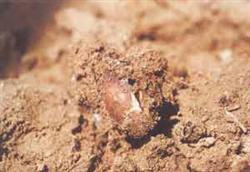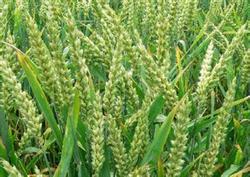Weeding in barley field

It is understood that there are only three herbicides registered to control weeds in barley fields, such as Dabuma, Yankui and Chloromuron, which have a certain control effect on Gramineae weeds. Among them, because of the certain drug damage caused by the use of barley, it has not been sold in the market of our province at present; green malon is a soil sealing treatment agent, which should be used mainly before sowing; wild swallow is suitable for the control of wild oats in barley field. Wild oat is a selective stem and leaf treatment agent with high efficiency and low toxicity. The drug is mainly absorbed through the ligule and base of wild oat, most of which moves to the top, destroying the cell division and elongation of apical and Internode meristem, stopping the growth and forming withered spots on the leaves until death. The herbicide spectrum is very narrow, and it is only suitable for single wheat fields of wild oats, and it can also be used in fields where wild oats are mixed with Triticum aestivum. Generally, the weeds should be sprayed from 3-leaf stage to tillering stage. Wild swine can not be mixed with sodium salt, potassium herbicide and 2-methyl-4-chloropropionic acid, nor can it be used immediately, at least 7 days apart. When the pesticide was applied under the condition of high soil moisture and air humidity, the penetration effect was enhanced and the efficacy was improved. The relative humidity is below 65% and the temperature is below 15 ℃. In order to ensure the control effect, there should be no rain within 4 hours after application. The application of wild swallows in wheat fields also had an effect on wheat seedlings under the condition of high temperature or low temperature and when the dosage was too high, showing that the leaves turned yellow, the more drugs were used, the more serious the damage was, the light ones could return to normal growth after 20 days, and the serious stalks were shortened. the heading and ripening period was delayed and the yield decreased. At present, the wild wilt products registered in China for barley fields are only 64% of the wild oat soluble powder of Germany BASF Co., Ltd. (Tel: 65876608). This product is registered for the control of wild oats in barley and wheat fields. the recommended dosage of pure medicine per hectare is 750 and 1200 grams, or about 64 percent of wild oat soluble powder 80 grams per mu. Similar products include 400g / L wild swallow water agent and 65% wild oat soluble powder (trade name Delibang) of Shaanxi Agricultural University Delibang Science and Technology Co., Ltd. (Tel: 86301562), all of which are registered for the control of wild oats in wheat fields. the recommended dosage of pure medicine is 1200,500g per hectare. The killing spectrum of wild swallow is very narrow, but there are often many species of Gramineae weeds in wheat field, so we can not rely solely on wild swallow to control Gramineae weeds in barley field. In addition, there are few stem and leaf treatment agents suitable for controlling Gramineae weeds in barley field. Puma, Maiji and other common herbicides suitable for controlling Gramineae weeds in wheat field can not be applied in barley field, otherwise it is easy to cause drug damage. Therefore, the early control of Gramineae weeds in barley field should be based on. Especially when the grass phase in the field is complex, it is best to seal the soil with herbicides such as Acetochlor, isoproturon and chlorotoluron before sowing, and then treat the stems and leaves with herbicides such as isoproturon at the weed seedling stage. Most of Gramineae weeds in wheat field emerge from sowing to winter, but few in winter and spring. Using medicine during the critical period from sowing to overwintering can effectively control the harm of Gramineae weeds.
- Prev

How to prevent the rotten seeds of spring peanuts after sowing
Rotten seeds often occur before emergence of spring peanuts after sowing, and the serious rate of rotten seeds is as high as 20%, resulting in varying degrees of lack of seedlings and broken ridges. Causes of rotten seed: poor seed quality or improper storage, long storage period, low-lying terrain, soil viscosity, poor texture, high soil water content, long seedling emergence time, unsolid soil preparation, affecting species.
- Next

Production of malting barley by seeking advantages and avoiding disadvantages
Under the influence of warm winter climate, the tiller of malting barley increased, the population became larger, the fertility was advanced, the jointing was earlier, it was easy to suffer from cold injury in late spring, and the risk of lodging increased. According to the reality of climate warming in winter, taking measures to prevent possible freezing injury and lodging in malting barley production can maximize profit.
Related
- The first cup of black tea in spring, the flavor and history of tea gardens in Kenya, Africa
- The computer can not only choose potatoes, but also grow tea rice. AI will grow winter oolong tea champion.
- It is not only the inflated tea bitten by insects, but also engraved with the four seasons tea in Beipu.
- The Oriental Beauty Tea Festival in Zhuxian County takes the stage at the weekend to experience the plus-size feast of oil tea.
- & quot; Oriental Beauty Tea & Exploration of Emei in Hsinchu, the hometown of quot;
- The new variety of strawberry "Tainong 1" dessert is the first choice with mellow aroma. Crimson gorgeous
- History of Tea in Taiwan: from Wild Inner Mountain to Export Tea Garden
- Two types of Taiwan Oriental Beauty Black Tea won the British three-Star Award for Childhood Tea Xiang Zhang Jiaqi changed from pilot to champion tea maker.
- Banana species and varieties: the planting history of Taiwan Xianren banana and dwarf banana is long, is banana disease resistant?
- Coffee planting Technology: Qianjie Coffee from Seedling to harvesting

